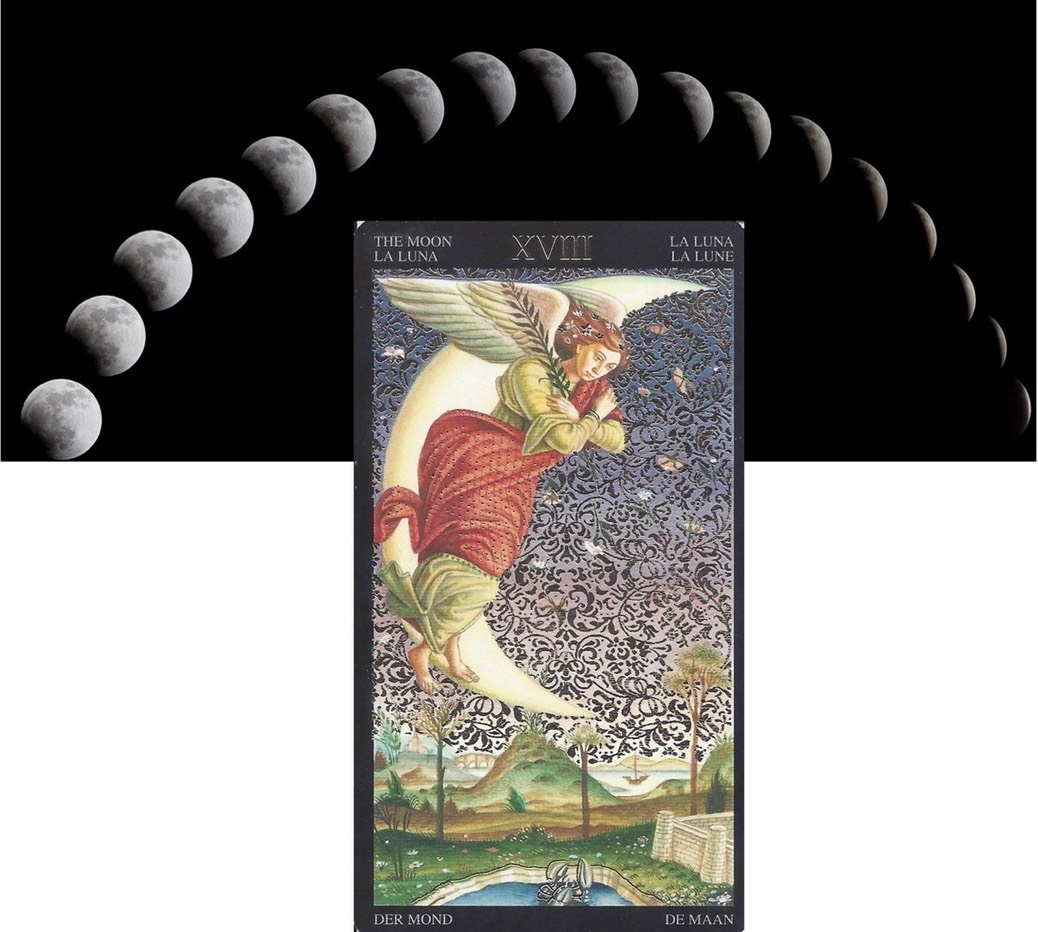Astrology’s Moon and the Major Arcana
By Lalia Wilson
The Major Arcana Moon is from The Golden Botticelli Tarot
by Atanas Alexandrov Atanassov
Published by Llewellyn Publications
How is astrology’s Moon reflected in the tarot? Could understanding both systems illuminate our knowledge of tarot and astrology, thus allowing us to better serve others? Better yet, can we understand women and femininity better if we see how the attributes of the feminine have been parsed out among the Major Arcana?
Hajo Banzhaf wrote an article about Tarot and Astrology, published in 2005 in The Astrological Journal (and available as a free PDF online), which shows ten different correspondences between astrology and tarot’s major arcana. Of the ten correspondences, eight ascribe astrology’s Moon to the High Priestess, one to The Moon, and one correspondence did not include the planets, only the signs of the zodiac.
To the novice, whether in tarot or in astrology, it seems a no-brainer, Moon = Moon, right? But it is not that simple. To begin, astrology pretty much takes all feminine qualities and divides them between the Moon and Venus. Only in recent times has astrology added the Big Four Asteroids: Ceres, Juno, Pallas and Vesta, plus the Dark Moon Lilith and the new planet Eris. Many astrologers, and probably more men than women, don’t use these six additional feminine elements. Instead they stick with the old Moon and Venus—mother and potential sexual partner, soother and arouser, plump versus buxom, wren-like or attention-getting. Sacred or profane. Madonna or whore. Cuddly doll versus Barbie doll. You’ve heard and seen this way of compartmentalizing women. Venus and its traditional association with The Empress card has been discussed in a separate article. Here, we will look at astrology’s Moon and how it is reflected in the Tarot.
In astrology there are many things associated with the Moon. Not all of them translate to specific tarot cards. Here are some of the associations:
- Social Role: Mother, legitimate mother, adoptive mother, nurse, infant caregiver, preschool teacher, nanny and cook.
- Political stance: Pro-family, pro-birth, pro-early education and programs for mothers and infants.
- Primary focus: Infants, toddlers, pregnant women, young mothers, fertility, nurturing feelings and emotions in self and others, interested in food and home and cooking. The youngest child (baby) always has priority and sets the schedule.
- Communication: emotional, usually soft.
- Emotions: Moody, changeable emotions, very sentimental, overly-emotive by most other’s standards.
- Sphere of action: stays at home, settled, home-loving, seeks out beaches and the ocean for vacations. She is high-touch and affectionate, has lots of practical knowledge about babies, children and home-management. She is low-tech, but curious about genealogy and a family history buff. Above all, she is astute to non-verbal cues given off by others, especially family members.
- Energy: relaxed, quiet, slow-moving, restful, comforting, cyclic.
- Appearance: The Moon has a round face and is very feminine, rounded and soft, with noticeable breasts, luminous skin, and long hair. She wears whites and light colors, usually as a dress or skirt which flows. She may have a child or baby with her—in her lap or in her arms.
- Foods: Dairy foods: milk, cream, ice cream, whipped cream, cheese, shellfish, ethnic heritage foods, and patriotic foods.
- Negatives: almost entirely emotionally driven, not intellectual (even if smart), prone to over-mother children and relatives.
With these attributes, let’s look at the Major Arcana to see what might approach astrology’s Moon in meaning. For our purposes, we will ignore the food section. Let’s begin with seeing the Moon as a woman. In the traditional Rider-Waite Major Arcana, we don’t have that many women. Those appearing are in The High Priestess, The Empress, The Lovers, Strength, Temperance, The Star, Judgment, and The World. In The Lovers we have a naked woman as a side figure (similarly in The Devil and Judgment), and an angel who could be female. We also have angel figures in Temperance and Judgment. Whether we want to call the three angels “female” or not, they are quite far from the definition of the Moon above. Discounting the side figures in The Lovers, The Devil and Judgment, this leaves us with five possibilities: The High Priestess, The Empress, Strength, The Star and The World. Only one of these might be commonly depicted with infants or young children, and she, The Empress, is also associated with another Moon attribute—fertility. However The Empress is more commonly associated with the planet Venus.
Now remember these attributes: feminine, flowing garments, quiet, slow-moving, restful. They clearly do not describe Strength or The Star, or The World. Instead they describe The High Priestess. However, she is not 100% astrology’s Moon. There is only some overlap. The High Priestess has many attributes of other feminine archetypes in astrology, particularly Vesta, who is a priestess herself.
Let us return to Tarot’s Moon. This card is about irrationality, major mood swings, giving way to primitive impulses; it is not dressed up or sentimental. Tarot’s Moon is not astrology’s Moon. Astrology’s Moon is best matched, though imperfectly, with The High Priestess.
